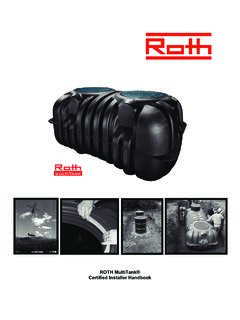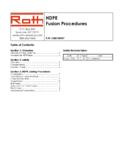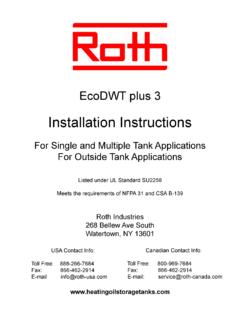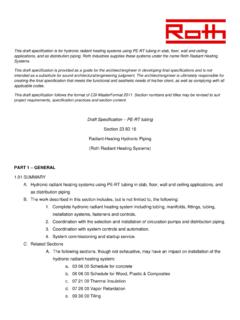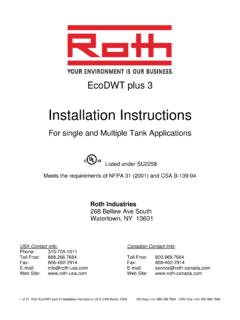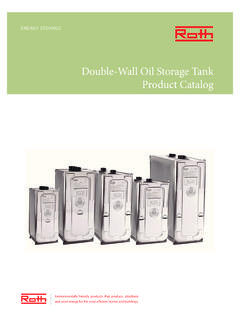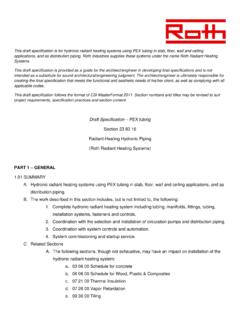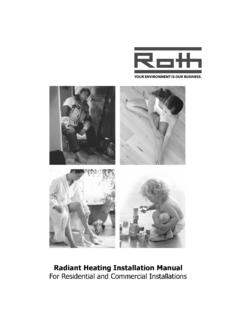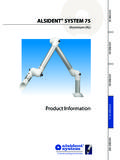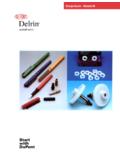Transcription of SECTION 334310 - POLYETHYLENE SEPTIC SYSTEM …
1 March 2015 POLYETHYLENE SEPTIC SYSTEM Tanks 334310 - - 1 SECTION 334310 - POLYETHYLENE SEPTIC SYSTEM TANKS PART 1 GENERAL Contractor shall furnish and install _____ (Qty) Roth MultiTank or equivalent HDPE POLYETHYLENE SEPTIC tanks plus fittings and fixtures as necessary. The tank shall be of _____gallons capacity and shall meet all requirements of _____. As such, the tank shall have_____compartments, _____ 24 diameter manhole openings, and riser SYSTEM as specified herein. Reference: All tanks provided must be certified to and/or listed with both CSA and IAPMO. CSA and UPC (IAPMO) marks must be clearly molded into the tank.
2 In addition, all state and local regulations and codes shall be followed. Standards The following generally recognized testing methods for plastic materials shall apply: ASTM D 1248 Standard Specification for POLYETHYLENE Plastics Extrusion Materials for Wire and Cable; ASTM D 1693 Standard Test Method for Environmental Stress-Cracking of Ethylene Plastics; ASTM D638 - Standard Test Method for Tensile Properties of Plastics; CSA International - B66-00 Prefabricated SEPTIC Tanks and Sewage Holding Tanks; International Association of Plumbing and Mechanical Officials IAPMO PS 1-98 Material and Property Standard for Prefabricated SEPTIC Tanks. ASTM D790 - Test Methods for Flexural Properties of Unreinforced and Reinforced Plastics and Electrical Insulating Materials Locating Services Prior to excavating, contact local underground utility location service to coordinate location and identification of existing underground services.
3 Product Delivery, Storage, and Handling A. Upon arrival, inspect tank, including the interior, for any damage that may have occurred during handling or transportation. Remove damaged or rejected materials from site. March 2015 POLYETHYLENE SEPTIC SYSTEM Tanks 334310 - - 2 B. Store tank on flat surface and secure against movement. C. Prevent damage to tank during setting and connection. Project Conditions A. Environmental: Contactor to comply with all federal, state, and local environmental requirements and setbacks. B. Safety: The contractor shall keep the site and excavations in a safe a satisfactory condition during the progress of the work.
4 PART 2 PRODUCTS Material The POLYETHYLENE used shall comply with ASTM Standard Dl248, Specification for POLYETHYLENE Plastics Molding and Extrusion Materials. Raw materials shall meet or exceed the following: D1248, Class B - requiring ultraviolet stabilizer or D1248, Class C - requiring a minimum 1% carbon black and D638 Tensile strength of 2,400 pounds or greater D1693 Environmental stress crack resistance of 150 hours or more D790 Flexural modulus of elasticity of 85,000 pounds or greater Tank Construction A. All tanks shall be of monolithic construction and shall be blow molded using high molecular weight HDPE resin. There shall be no metal parts molded into POLYETHYLENE tanks. Field assembly or modification of tanks is strictly prohibited with the exception of basic piping systems and risers.
5 B. Wall Thickness and Tank Weight Wall thickness of all POLYETHYLENE tanks shall be determined by manufacturer's design to meet performance standards as set forth in SECTION 3 and shall be a minimum of inches. Internal baffles and partitions shall be determined by manufacturer's design to meet performance standards as set forth in SECTION 3 and shall be a minimum of inches. The tanks shall have a minimum weight to volume ratio of pounds per total gallon of capacity. This ratio shall be calculated by dividing the net weight of the tank only (without lids, risers, compartment walls, t-baffles etc.) by the total capacity March 2015 POLYETHYLENE SEPTIC SYSTEM Tanks 334310 - - 3 of the tank.
6 Total capacity shall be defined as the volume in gallons of the tank when completely filled and without airspace. C. Tank Pumping All tanks shall have sufficient structural integrity to withstand being pumped dry without incurring structural deformation ( rib collapse). D. Riser Connections All risers shall be watertight, available in 6-inch increments and be able to extend to grade from the maximum burial depth. Riser covers shall be lockable. PART 3 EXECUTION Site Preparation A. Obtain required installation permit from local jurisdiction B. Review safety procedures with all employees C. Establish and verify tank location and elevation. Tank should be buried no greater than 36 inches below grade. Excavation for Structure A. Establish tank subgrade elevation and over excavate to a minimum of 6 inches below bottom of tank.
7 Excavate to provide 2 feet of horizontal clearance between outer surface of structure and trench wall to allow for proper backfilling. Place a minimum of 6 inches of well-graded clean stone (minimum 1/8 to 3/4-inch diameter) or coarse sand over subgrade and rake smooth. B. Where rock is encountered such that the structure would bear on rock, remove the rock to a minimum of 8 inches below the structure and place an 8-inch cushion of clean stone over the exposed rock. Tank Installation A. Identify the inlet and outlet ends of the tank. Inlet and outlet may be located on the end of either side ports (per local code requirements). Identify drill location based on liquid level. Drill the inlet and outlet holes using a 5-inch diameter hole saw. B. Install manufacturer provided rubber gasket in inlet and outlet ports.
8 C. Install the inlet and outlet tees. March 2015 POLYETHYLENE SEPTIC SYSTEM Tanks 334310 - - 4 D. Install the required ROTH MULTITANK threaded SEPTIC Access Riser SYSTEM . E. Using the corner lifting holes, lower the tank into the excavation. Level the tank and verify the outlet is lower than the inlet. Install remaining inlet and outlet plumbing. F. Perform required water tightness, plumbing, and/or tank inspections as applicable. Fastening of Fittings Fastening of internal walls or partitions shall be done using a corrosion resistant fastening SYSTEM . Under no circumstances shall any fastening SYSTEM penetrate the tank walls. Pipe Connections All pipe connections shall be watertight.
9 Tanks shall be capable of accommodating pipe penetrations on each end and on either side where allowed by local Codes. Backfilling A. Verify the height of the risers and modify/adjust as required. Mark the riser locations on a drawing using permanent landmark features as reference. A minimum of 2 and preferably 3 ties per riser are recommended. B. Back fill in an alternating method around tank in 6- to 8-inch lifts. C. Backfill material may be native soils provided soil is free of debris, organic matter, sharp stones, and stones greater than 2 inches in diameter. However, soil must be able to freely flow into corrugations between tank ribs, including midpoint to bell of tank. D. Care shall be taken to prevent any disturbance to the structure or newly made joints. The filling of the trench shall be carried on simultaneously on both sides of the tank in such a manner that injurious side pressures do not occur such that the tank could be displaced or dislodged.
10 Tank installer may place water in tank to stabilize tank during backfilling. E. Do not backfill with muddy or frozen soil. Testing & Structural Strength Testing A. Volumes, Capacities, Rates & Dimensions Any or all of the following methods shall determine all volumes, capacities, rates, and dimensions: 1. Mathematically March 2015 POLYETHYLENE SEPTIC SYSTEM Tanks 334310 - - 5 2. By actual measurement of the volume of water and/or; 3. By weighing tank before and after filling tank with water B. Vacuum Test 1. Seal the empty tank and apply an internal vacuum of inches of mercury per foot of maximum depth of earth cover as recommended by the manufacturer, with such depth a maximum of 36" (note: Roth MultiTank tanks may be buried at greater depths upon consultation with Factory) 2.
